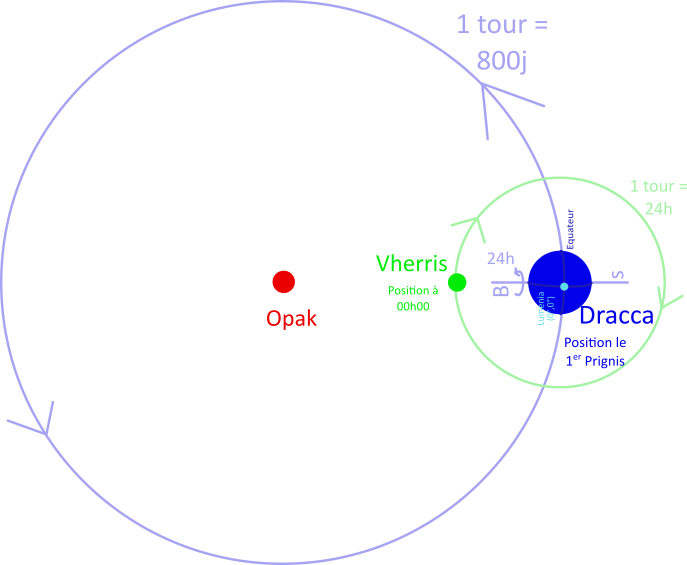Dracca
Main planet of this universe, about the size of Earth. UV rays from the white dwarf Opak heats this planet, while its satellite Vherris lights it. Climate and day/night cycles can then be very different depending on where you are on this planet: some islands are neverending nights, others are neverending days.
Planet
Draggia
Before being hit by Vherra, Dracca was named Draggia, so these names refer to the same planet, at different time.
Dracca
Home of dragons and other fantastic creatures, the planet is full of islands lost in a wide ocean. A lot of crystals can be found on and under ground. Unlike Earth, its spinning axis is horizontal.
Climate
The horizontal spinning axis of the planet means that each hemisphere is facing the star a quarter of the year, during the heat season, and is hidden from the star for another quarter of the year, in the cold seaon. Because day/night cycle and warm/cold cycles are unrelated, these poles stay warm or cold all day and night: the temperature remains the same, no matter whether it's midday or midnight. But in the middle seaon (the rest of the year, so half a year), poles are alternatively facing the white dwarf, and opposed to it, making a quick alternance between warm and cold. Places inbetween the poles follow the same kind of rules.

Day/Night cycles
Vherris is a satellite that lights Dracca by turning Opak's UV rays into normal light. Hence, bright days can be very cold (for instance, at a pole on the opposite site of Opak), and nights can be heatwavy. Day/night cycle remains the same all year long, but varies depending on your position on the planet. Daylight last about 12h on the poles, but along the equador, some islands are bathed in an eternal daylight like Lumenia, while others never saw a lightbeam. This explains why Lumenia is considered as the origin point of maps (0°Boreas, 0°Ponor).
Satellites
Draggis
Draggis is made of Dracca's dust thrown in space by the impact with Vherra. It emit no light, but only rethrow the one from Vherris. Depending on Vherris' light polarisation, Draggis goes from purple ("new Moon"), blue, cyan, green, red, yellow ("full Moon"), then green, cyan, blue, purple until it gets almost hidden for an octain. Last, Draggis is way heavier than Vherris, and so is responsible for the tides.
Vherris
Ancient core of Vherra, Vherris is made of pure crystal. It turns the UV rays from Opak into bright normal light. It appears like a small dot in the sky, compared to the moon. Vherris color can change depending on the light's polarisation. Last, it is a too small satellite to cause tides.
Collision with Vherra
Millions years ago, the planet Vherra striken Draggia, after Rougeil imploded and became the white dwarf Opak. The Helium flash emitted blew out Vherra's surface, leaving only it core. That core slowly moved away from the white dwarf, and started to become crystal, until it strikes the planet Dracca. This event is the begining of the Krystallostic era. During the next following thousands years, the crystal particles this collision threw in the air started to fall down, covering the planet of crystal structures. The remainings of the core rebounded to the space, and became the satellite Vherris. Since then, Draggia was renamed to Dracca, and thanks to all these crystal, Dragons appeared.
 All the knowledges about Dracca's universe
All the knowledges about Dracca's universe